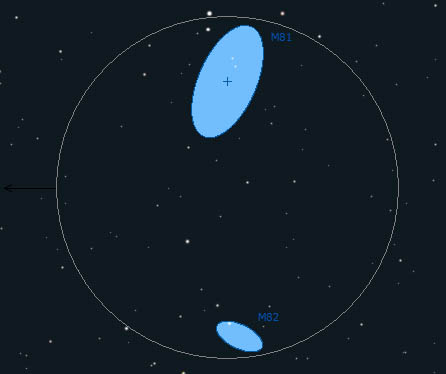|
This famous pair of galaxies is worth looking at again
and again. Discovered by Bode in 1774, tthese 7th and 9th
magnitude galaxies are fine objects in any telescope, even binoculars.
M81, which is also known as Bode's Nebula (and NGC
3031), is a nearly face on spiral galaxy that spans 25' x 12'. Look for
a bright central condensation with a nearly stellar center. Large aperture
scopes with wide fields of view may reveal the wispy spiral arms that surround
the bright portion of the galaxy.
M82 (NGC 3034) is a nearly edge-on irregular spiral
galaxy that spans 10' x 5'. In telescopes smaller than 10" this galaxy
appears to be a normal spiral. Larger instruments may reveal bright knots
cut by dark lanes.
I observed M 81 & M 82 in my 18-inch Dob. Here are my notes from that session:
M81 & M82 cleared the tree to my northeast
and I had a look for the first time in my 18-icnh. I've observed these
galaxies in all sorts of instruments, including some much larger, but once
again I was stunned by the view in my 18-inch. I don't know if its my location
or what, but I've never seen so much detail in M82 before. It was like
a photograph. I couldn't get over the contrast in the dust lanes! Whatever
the reason, I know I'm very lucky to have such access to the sky from my
own back yard. M81 was it's usual, large, smooth self. It may be sort of
boring, but if you think about it there is a certain beauty to its regular
smoothness.
The observation of rapidly expanding filaments of gas
in M82 galaxy lead to the controversial idea of "exploding galaxies" in
the late 1970's. This idea, which was quickly abandoned, spawned at least
one science fiction story. We now understand M82 as a Starburst galaxy that is
interacting with its neighbor, M81. These two galaxies share a common
envelope of neutral hydrogen gas. A Starburst galaxy is a galaxy that has
been triggered to form large numbers of stars, typically due to a collision
or interaction with another galaxy. In computer simulations, when two galaxies
collide the tiny
stars simply pass right by one another, but the giant molecular gas clouds
from which stars form actually collide. Collisions between giant molecular
clouds can occur when two galaxies pass through one another or as a result
of gravitational interaction between two nearby galaxies.
The exact interaction is still unknown, but it appears
that the gas clouds in M82 have been colliding. The resulting shocks have
triggered a burst of star formation at a much higher rate than in a normal
spiral galaxy. Hot, massive, but short-lived stars abound, making the newly
formed star clusters much brighter than those found in our own galaxy.

The view in a 6" at 50x. North is down, East is to
the right.
|